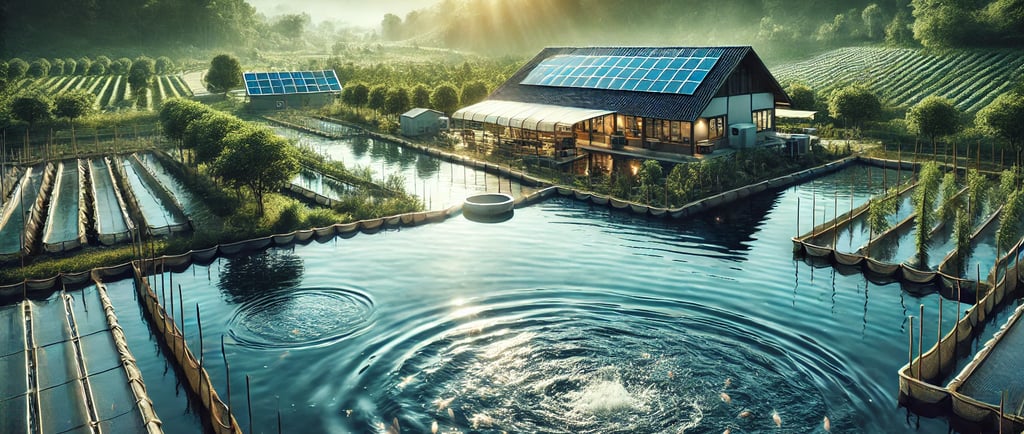How to Choose the Right Location for a Fish Farm
Fish farming is rapidly growing, offering a profitable and sustainable way to meet global fish demand. The key to success lies in selecting the right location—ensuring access to quality water, suitable land, market access, and necessary resources. This guide covers everything you need to know for a thriving fish farm.


Why Is Location Important for Fish Farming?
The location of your fish farm impacts every aspect of your operations. It determines:
Water availability and quality: Fish need clean and oxygen-rich water to grow healthily.
Ease of operations: Accessibility and infrastructure affect the day-to-day running of your farm.
Costs: Location influences costs for water, land, labor, and transportation.
Sustainability: Choosing a location with minimal environmental risks helps ensure long-term success.
A good location can optimize production while minimizing risks and costs.
Factors to Consider When Choosing a Location
1. Water Source and Quality
Water is the lifeblood of any fish farm. The type, availability, and quality of water will directly affect the health and growth of your fish.
Types of water sources:
Rivers and streams: Ideal for flow-through systems but may require filtration.
Ponds or lakes: Suitable for earthen ponds but ensure they are not polluted.
Groundwater: Reliable and stable but may need aeration due to low oxygen levels.
Key factors to check for water quality:
pH level: Ideally between 6.5 and 8.5.
Temperature: The temperature should be suitable for the species you plan to farm.
Dissolved oxygen: Essential for fish survival; aim for levels above 5 mg/L.
Free of pollutants: Avoid areas with industrial or agricultural runoff.
2. Soil Type
For pond-based fish farms, soil quality plays a vital role. Good soil ensures that ponds retain water effectively and support aquatic life.
Ideal soil properties:
Clay or loamy soil: Retains water well.
Avoid sandy soil: Prone to seepage.
Test for soil pH: Optimal range is 6.5 to 8.
Soil testing is a simple but crucial step. It can save you time and money in the long run.
3. Climate Conditions
The local climate determines which fish species will thrive on your farm. For example:
Warm climates: Suitable for species like tilapia, catfish, and prawns.
Cold climates: Ideal for trout, salmon, and carp.
Consider the following:
Seasonal temperature variations.
Rainfall patterns (to prevent flooding or water shortages).
Risk of extreme weather (storms, droughts, or heavy rains).
4. Accessibility and Infrastructure
A fish farm’s location should be easily accessible to ensure smooth operations and logistics.
Road access: Essential for transporting supplies and harvested fish.
Proximity to markets: Reduces transportation costs and ensures fresh delivery to consumers.
Electricity and water supply: Stable power is needed for pumps, aerators, and other equipment.
Labor availability: Having skilled or trainable workers nearby is a plus.
5. Size of the Land
The size of your fish farm depends on your production goals and budget. Ensure the land can accommodate the following:
Fish ponds or tanks.
Storage facilities.
Feed and equipment storage.
Office and staff areas.
6. Legal and Regulatory Compliance
location, research the legal requirements for fish Non-compliance can lead to fines, legal troubles, or even closure of your farm. Before finalizing a farming in your area.
Licenses and permits: Obtain necessary permissions for water use, land use, and environmental clearance.
Zoning laws: Ensure the land is designated for agricultural or aquaculture use.
Environmental impact: Avoid locations that could harm sensitive ecosystems.
7. Proximity to Feed and Equipment Suppliers
Fish feed and equipment are essential for your operations. Choosing a location close to suppliers can reduce costs and ensure timely availability of resources.
Ensure that high-quality fish feed is easily accessible.
Look for local suppliers of nets, aerators, and other aquaculture equipment.
8. Potential Risks
Evaluate potential risks that could affect your fish farm, including:
Flooding: Choose higher ground to avoid flood-prone areas.
Predators: Be aware of animals or birds that could harm your fish.
Pollution: Avoid areas near industrial or urban runoff.
Steps to Select the Right Location
Step 1: Conduct Research
Start by gathering information about:
Local climate and weather patterns.
Availability of water sources.
Common fish species farmed in the area.
Step 2: Visit Potential Sites
Visit multiple locations to compare:
Water quality and soil type.
Accessibility and infrastructure.
Overall feasibility of setting up a fish farm.
Step 3: Perform Tests
Before making a decision, test the water and soil quality at your preferred site. Work with local experts or agricultural extension offices to ensure accuracy.
Step 4: Evaluate Costs
Compare costs for:
Land purchase or lease.
Setting up ponds or tanks.
Installing equipment and infrastructure.
Day-to-day operations.
Step 5: Check Legal Requirements
Ensure the site meets all regulatory and zoning requirements. Obtain necessary permits and licenses before beginning construction.
Step 6: Seek Expert Advice
Consult with aquaculture experts or local fishery consultants to validate your choice. They can offer valuable insights and recommendations.
Common Mistakes to Avoid
Ignoring water quality: Poor water quality can lead to fish diseases and low productivity.
Overlooking soil testing: Soil that doesn’t retain water can increase operational costs.
Underestimating risks: Flood-prone or predator-heavy areas can be disastrous.
Focusing only on costs: A cheaper location might have hidden long-term challenges.
Neglecting legal compliance: Operating without proper permits can lead to fines or shutdowns.
Conclusion
Choosing the right location for your fish farm is a crucial step that requires careful consideration of multiple factors. Prioritize water quality, soil type, accessibility, and compliance with legal regulations to set your business up for success. Conduct thorough research, seek expert advice, and evaluate all risks and costs before making your final decision.
A well-located fish farm not only ensures better productivity but also reduces operational challenges, helping you build a sustainable and profitable business.
Start your journey today, and you’ll be on the path to becoming a successful fish farmer!
